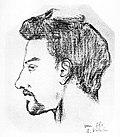Suzanne Valadon
 From Wikipedia - Reading time: 19 min
From Wikipedia - Reading time: 19 min
Suzanne Valadon | |
|---|---|
 Self-portrait, 1898, Museum of Fine Arts Houston | |
| Born | Marie-Clémentine Valadon 23 September 1865 Bessines-sur-Gartempe, France |
| Died | 7 April 1938 (aged 72) Paris, France |
| Nationality | French |
| Known for | Painter |
| Movement | Post-Impressionism, Symbolism |
| Spouses |
|
| Partner(s) | Erik Satie, Henri de Toulouse-Lautrec |
Suzanne Valadon (French pronunciation: [syzan valadɔ̃]; 23 September 1865 – 7 April 1938) was a French painter who was born Marie-Clémentine Valadon at Bessines-sur-Gartempe, Haute-Vienne, France. In 1894, Valadon became the first woman painter admitted to the Société Nationale des Beaux-Arts. She was also the mother of painter Maurice Utrillo.
Valadon spent nearly 40 years of her life as an artist.[1] The subjects of her drawings and paintings, such as Joy of Life (1911), included mostly female nudes, portraits of women, still lifes, and landscapes. She never attended the academy and was never confined within a set tradition or style of art.[2] Despite not being confined to any tradition, she shocked the art world as the first woman painter to depict a male nude as well as less idealized images of women in comparison to those of her male counterparts.[3]
She was a model for many renowned artists. Among them, Valadon appeared in such paintings as Dance at Bougival (1883) and Dance in the City by Pierre-Auguste Renoir (1883), and Suzanne Valadon (1885) and The Hangover (Suzanne Valadon) (1887–1889) by Henri de Toulouse-Lautrec.
Early life
[edit]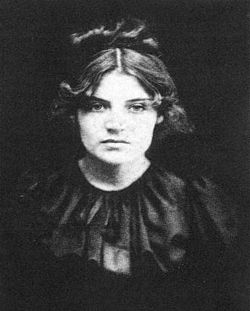
Valadon grew up in poverty with her mother, an unmarried laundress in Montmartre.[4] She did not know her father. Known to be quite independent and rebellious, she attended primary school until age eleven when she began working.
She had a series of jobs that included working in a milliner's workshop, at a factory making funeral wreaths, selling vegetables, and as a waitress. At the age of 15, she obtained a job in her most desired field: performing in the circus as an acrobat. She was able to work at the circus because of her connection with Count Antoine de La Rochefoucauld and Thèo Wagner, two symbolist painters, who were involved in decorating a circus belonging to Medrano. The circus was visited frequently by artists such as Toulouse-Lautrec and Berthe Morisot and it is speculated that this was the inspiration for a painting of Valadon by Morisot.[5] A fall from a trapeze that injured her back is what ultimately ended her circus career after one year.
It is commonly believed that Valadon taught herself how to draw at the age of nine.[6] In the Montmartre quarter of Paris, she pursued her interest in art, first working as a model and a muse for artists, observing and learning their techniques, as she could not afford art lessons herself. She observed and learned from artists, such as Pierre Puvis de Chavannes, Henri de Toulouse-Lautrec, and Pierre-Auguste Renoir, before becoming a noted and successful painter in her own right.[7][8]
Model
[edit]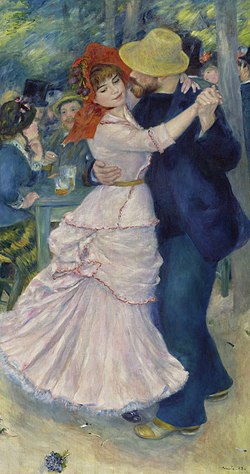
Valadon began working as a model in 1880 in Montmartre at age 15.[9] She modeled for more than ten years for many different artists including Berthe Morisot,[10] Pierre-Cécile Puvis de Chavannes, Théophile Steinlen, Pierre-Auguste Renoir, Jean-Jacques Henner, and Henri de Toulouse-Lautrec.[1] She modeled under the name "Maria" before being nicknamed "Suzanne" by Toulouse-Lautrec, after the biblical story of Susanna and the Elders as he felt that she especially preferred modeling for older artists.[11][12] She was Toulouse-Lautrec's lover for two years, which ended when she attempted suicide in 1888.[13][2]
Valadon learned and furthered her art by observing the techniques of the artists for whom she posed.[2] She was considered a very focused, ambitious, rebellious, determined, self-confident, and passionate woman.[14] In the early 1890s, she befriended Edgar Degas, who was impressed by her bold line drawings and fine paintings. He purchased her work and encouraged her. She remained one of his closest friends until his death in 1917. Art historian Heather Dawkins believed that Valadon's experience as a model added depth to her own images of nude women, which tended to be less idealized than the representations of women by the male post-impressionists.[15]
Morisot's 1880 drawing of Valadon as a tightrope walker preceded it, but the most recognizable early image of Valadon is in Renoir's Dance at Bougival from 1883, the same year that she posed for Dance in the City.[16] In 1885, Renoir painted her portrait again as Girl Braiding Her Hair. Another of his portraits of her in 1885, Suzanne Valadon, is of her head and shoulders in profile. Valadon frequented the bars and taverns of Paris with her fellow painters and she was Toulouse-Lautrec's subject in his oil painting The Hangover.[17]
Artist
[edit]
Valadon was an acclaimed painter of her time, well-respected and championed by contemporaries such as Edgar Degas and Pierre-Auguste Renoir. She was admitted to professional associations and her works were admitted to juried exhibitions. She lived a bohemian life with rebellious vision.[18]
Valadon's earliest surviving signed and dated work is a self-portrait from 1883, drawn in charcoal and pastel.[6] She produced mostly drawings between 1883 and 1893, and began painting in 1892. Her first models were family members, especially her son, mother, and niece.[19]
Valadon began painting full-time in 1896.[6] She painted still lifes, portraits, flowers, and landscapes that are noted for their strong composition and vibrant colors. She was, however, best known for her candid female nudes.[20] Her work attracted attention partly because, by painting unidealized nudes, she upset the social norms of the time that had been created by male artists.[21]
Her earliest known female nude was executed in 1892.[22] In 1895, the art dealer Paul Durand-Ruel exhibited a group of twelve etchings by Valadon that show women in various stages of their toilettes.[6] Later, she regularly showed at Galerie Bernheim-Jeune in Paris.[23] Valadon was the first woman painter accepted as an exhibitor in the Salon de la Nationale in 1894,[24] which is notable since competition for acceptance was fierce.
She exhibited in the Salon d'Automne from 1909, in the Salon des Independants from 1911, and in the Salon des Femmes Artistes Modernes from 1933 to 1938.[25] Notably, Degas was the first person to purchase drawings from her,[26] and he introduced her to other collectors, including Paul Durand-Ruel and Ambroise Vollard. Degas also taught her the skill of soft-ground etching.[27]
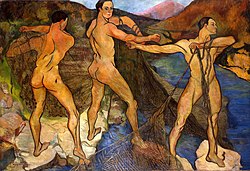
After her 1895 marriage to the well-to-do banker Paul Mousis, Valadon became a full-time painter the following year.[6] She made a shift from drawing to painting in 1909.[28] Her first large oils for the Salon related to sexual pleasures and they were some of the first examples in modern painting with a man being an object of desire by a woman similar to that idealized treatment of women by male artists. These notable Salon paintings include Adam and Eve (Adam et Eve) (1909), Joy of Life (La Joie de vivre) (1911), and Casting the Net (Lancement du filet) (1914).[29] In her lifetime, Valadon produced approximately 273 drawings, 478 paintings, and 31 etchings, excluding pieces given away or destroyed.[30]
Valadon was well known during her lifetime, especially toward the end of her career, in the 1920s more specifically, as she helped to transform the female nude that depicted expression through a woman's experience.[31][page needed][32] Her works are in the collection of the Centre Georges Pompidou in Paris, the Museum of Grenoble, and the Metropolitan Museum of Art in New York, among others.
Valadon's painting of an acrobat, L' Acrobate ou La Roue, sold in 2017 for £75,000 by Christie's Auction House.[33]
Style
[edit]
Valadon was not confined to a specific style, yet both Symbolist and Post-Impressionist aesthetics are clearly demonstrated within her work.[34] She worked primarily with oil paint, oil pencils, pastels, and red chalk; she did not use ink or watercolor because these mediums were too fluid for her preference.[35] Valadon's paintings feature rich colors and bold, open brushwork often featuring firm black lines to define and outline her figures.[1]
Valadon's self-portraits, portraits, nudes, landscapes, and still lifes remain detached from trends and contemporaneous aspects of academic art.[36] The subjects of Valadon's paintings often reinvent the old master themes: women bathing, reclining nudes, and interior scenes. She preferred to paint working-class models. Art historian Patricia Mathews suggests that Valadon's working-class status and experience as a model influenced her intimate, familiar observation of these women and their bodies. In this respect she differed from Berthe Morisot and Mary Cassatt, who painted mostly women, but "remained well within the bounds of propriety in their subject matter" because of their upper-middle-class status in French society.[31][page needed] Valadon's marginalized status allowed her to enter the contemporary male dominated domain of art through modeling and her lack of formal academic training may have made her less influenced by academic conventions.[37] She has been noted for that difference in her paintings of the nude women.[38] She resisted typical depictions of women, emphasizing class trappings and their sexual attractiveness, through her realistic depiction of unidealised and self-possessed women who are not overly sexualised.[39] She also painted many nude self-portraits across the span of her career, the later of which displayed her aging body realistically.
Valadon emphasized the importance of the composition of her portraits over techniques such as painting expressive eyes.[35] Her later works, such as Blue Room (1923), are brighter in color and show a new emphasis on decorative backgrounds and patterned materials.[40]
Personal life
[edit]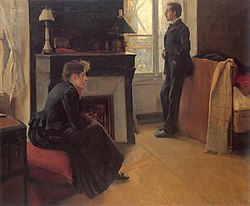
In 1883, aged 18, Valadon gave birth to a son, Maurice Utrillo.[1] Valadon's mother cared for Maurice while she returned to modelling.[14] Later, Valadon's friend Miquel Utrillo signed papers recognizing Maurice as his son, although the true paternity was never disclosed.[41]
In 1893, Valadon began a short-lived affair with composer Erik Satie, moving to a room next to his on the Rue Cortot. Satie became obsessed with her, calling her his Biqui, writing impassioned notes about "her whole being, lovely eyes, gentle hands, and tiny feet". After six months she left, leaving him devastated.[42]
Valadon married the stockbroker Paul Mousis in 1895. For 13 years, she lived with him in an apartment in Paris and in a house in the outlying region.[35] In 1909, Valadon began an affair with the painter André Utter, a 23-year-old friend of her son. He became a model for her and appears as Adam in Adam et Eve, which was painted that year. She divorced Mousis in 1913.[43] Valadon then married Utter in 1914.[6] Utter managed her career as well as that of her son.[44] Valadon and Utter regularly exhibited work together until the couple divorced in 1934, when Valadon was almost seventy.[44] They continued a relationship until her death, nonetheless, and are buried together in the Saint Ouen cemetery in Paris.
Suzanne Valadon died of a stroke[45] on 7 April 1938, at the age of 72, and was buried in Division 13 of the Cimetière de Saint-Ouen, Paris. Among those in attendance at the funeral were her friends and colleagues André Derain, Pablo Picasso, and Georges Braque.
Exhibitions
[edit]Group exhibitions
[edit]- 1894, Société Nationale des Beaux-Arts, Paris
- 1907, Galerie Eugène Blot, Paris
- 1909, Salon d'Automne, Grand Palais, Paris
- 1910, Salon d'Automne, Grand Palais, Paris
- 1911, Salon d'Automne, Grand Palais, Paris
- 1911 - continuing, Salon des Indépendants, Paris
- 1917, Utrillo, Valadon, Utter, Galerie Berthe Weill, Paris
- 1920, Second Exhibition of Young French Painting, Galerie Manzy Joyant, Paris
- 1921, Young Painting, Palais d'Ixelles
- 1926, (retrospective), Salon des Indépendants, Paris
- 1927, Salon des Tuileries, Paris
- 1928, Salon des Tuileries, Paris
- 1933-1938, Salon des Femmes Artistes Modernes, Paris
After her death in 1938
- 1940, 22nd Biennale Internationale des Beaux-Arts, Paris
- 1949, Great Trends in Contemporary Painting from Manet to our Day, Musée des Beaux-Arts, Lyons; 1961, Maurice Utrillo V. Suzanne Valadon, Haus der Kunst, Munich
- 1964, Documenta, Kassel
- 1969, Fourteenth Salon de Montrouge
- 1976, Women Artists (1550-1950), Los Angeles County Museum of Art
- 1979, Maurice Utrillo, Suzanne Valadon, Musée Toulouse-Lautrec
- 1991, Albi: Utrillo, Valadon, Utter, Chateau Constant, Bessines
- 1991, Utrillo, Valadon, Utter: la Trilogie Maudite, Acropolis, Nice
Solo exhibitions
[edit]- 1911, the first solo exhibition of the work of Suzanne Valadon, at the Galerie Clovis Sagot
- 1915, Galerie Berthe Weill, Paris
- 1919, Galerie Berthe Weill, Paris
- 1922, Galerie Bernheim-Jeune, Paris
- 1923, Galerie Bernheim-Jeune, Paris
- 1927, retrospective, Galerie Berthe Weill, Paris
- 1928, Galerie des Archers, Lyons
- 1928, Galerie Berthe Weill, Paris
- 1929, Galerie Bernheim-Jeune, Paris
- 1929, Galerie Bernier, Paris
- 1931, Galerie Le Portique, Paris
- 1931, Galerie Le Centaure, Brussels
- 1932, Galerie Le Portique, Paris
- 1932, retrospective with a preface by Édouard Herriot, Galerie Georges Petit, Paris
- 1937, Galerie Bernier, Paris
- 1938, Galerie Pétridès, Paris
- 1939, Galerie Bernier, Paris
- 1942, Galerie Pétridès, Paris
- 1947, Galerie Bernier, Paris
- 1947, Galerie Pétridès, Paris
- 1948, Tribute to Suzanne Valadon, Musée National d'Art Moderne, Paris
- 1956, The Lefevre Gallery, London
- 1959, Galerie Pétridès, Paris
- 1962, Galerie Pétridès, Paris
- 1967, Musée National d'Art Moderne, Paris
- 1996, Suzanne Valadon, Pierre Gianada Foundation, Martigny
- 2021, Barnes Foundation, September 26, 2021 to January 9, 2022, first major U.S. solo exhibition of Valadon's work [46][47][48][49]
- 2022, Glyptoteket, Copenhagen
Permanent collections
[edit]- Albright-Knox, Buffalo[50]
- British Museum, London[51]
- Carnegie Museum of Art, Pittsburgh[52]
- Dallas Museum of Art, Dallas[53]
- Detroit Institute of Arts[54]
- Fine Arts Museums of San Francisco[55]
- Harvard Art Museums, Cambridge[56]
- Indianapolis Museum of Art[57]
- Metropolitan Museum of Art[58]
- Minneapolis Institute of Art[59]
- Musée d'Unterlinden, Colmar[60]
- Musée des beaux-arts de Lyon[61]
- Museum of Fine Arts, Houston[62]
- Museum of Modern Art, New York[63]
- National Museum of Women in the Arts[64][6]
- Nelson-Atkins Museum of Art, Kansas City[65]
- Petit Palais, Geneva[66]
- Rose Art Museum, Waltham[67]
- Smart Museum of Art, Chicago[68]
- University of Michigan Museum of Art, Ann Arbor[69]
Gallery
[edit]Artwork by Valadon
[edit]-
Self-portrait, 1883
-
My son at seven years old, 1890
-
Portrait of Erik Satie, 1893
-
Nude, 1895
-
The Bath, 1908
-
Adam and Eve, by Suzanne Valadon, 1909
-
Nudes, 1919
-
Flowers on a Round Table, 1920
-
Portrait of the Painter Maurice Utrillo, 1921
-
The Blue Room (La chambre bleue), 1923
-
Still Life with Tulips and Fruit Bowl, 1924
-
Portrait of Maurice Utrillo, 1925
-
Bouquet of Flowers, 1928
-
Still Life with Basket of Apples Vase of Flowers, 1928
-
Three Woman Bathing, 1928
-
Young Girl in Front of a Window, 1930
-
Suzanne Valadon, Self-portrait
-
Bouquet de roses, 1936
-
Young Girl Bathing
-
Nude Woman with a Blue Shawl (1930)
Portraits of Valadon
[edit]-
Profile portrait of Suzanne Valadon, by Pierre-Auguste Renoir, 1885
-
Portrait of Valadon, by Pierre-Auguste Renoir, 1885
-
The Braid by Pierre-Auguste Renoir, 1886-1887
-
The Hangover (Suzanne Valadon), by Henri de Toulouse-Lautrec, c. 1888
-
Portrait of Suzanne Valadon, by Miquel Utrillo, 1891
-
Vestal reading (study), by Hector Leroux, c. 1892
-
Valadon by André Utter, 1921
Illustrations
[edit]- Jean Cocteau, Bertrand Guégan (1892-1943); L'almanach de Cocagne pour l'an 1920-1922, Dédié aux vrais Gourmands Et aux Francs Buveurs[70]
Feminist commentary
[edit]As one of the best documented French artists of the early twentieth century, Valadon's body of work has been of great interest to feminist art historians,[71][better source needed] especially given her focus on the female form. Her work was candid and occasionally awkward, often characterized by strong lines, and her resistance to both academic and avant-garde conventions for representing the female nude have encouraged interest in her work: It has been argued that many of her images of women signal a form of resistance to some of the dominant representations of female sexuality in early twentieth-century Western art. Many of her nudes painted from the 1910s onward are heavily proportioned and sometimes awkwardly posed. The feminist critics assert that they are conspicuously at odds with the svelte, 'feminine' type to be found in the imagery of both popular and 'high' art.[72] Her self-portrait from 1931, when she was 66, stands out as one of the early examples of a woman painter recording her own physical decline.[73]
Like many other talented female artists, although she is known to have been an important modern artist, Valadon never had been given a solo exhibition by a U.S. art institution. Her first institutional solo exhibition in the U.S., at the Barnes Foundation in Philadelphia, was scheduled to open in September 2021.[18]
Honors and legacy
[edit]Both an asteroid (6937 Valadon) and a crater on Venus are named in her honor.
The small square at the base of the Montmartre funicular in Paris is named Place Suzanne Valadon. At the top of the funicular, and less than 50 meters to its east, are the steps named rue Maurice Utrillo after her son the artist.
Depiction in novels and plays
[edit]A novel based on the life of Suzanne Valadon was written by Elaine Todd Koren and was published in 2001, titled Suzanne: of Love and Art.[74] An earlier novel by Sarah Baylis, Utrillo's Mother, was published first in England and later in the United States. Timberlake Wertenbaker's play, The Line (2009), traces the relationship between Valadon and Degas.[75] Several have speculated Valadon was the basis for the character Suzanne Rouvier in the W. Somerset Maugham's 1944 novel The Razor's Edge.[76][77] There were many parallels between Valadon's life and that of the Rouvier character.[78][76]
Suzanne Valadon’s relationships with Edgar Degas and Toulouse-Lautrec are described in R.w. Meek’s two historical fiction novels, The Dream Collector, Book I “Sabrine & Sigmund Freud” [79] and The Dream Collector, Book II “Sabrine & Vincent van Gogh.” [80]
See also
[edit]- Musée de Montmartre, established in the building in which Valadon had an apartment and studio, which are preserved
References
[edit]Citations
[edit]- ^ a b c d Marchesseau 1996, p. 9.
- ^ a b c Warnod 1981, p. 40.
- ^ "Suzanne Valadon". The Art Story Foundation. Retrieved 17 March 2023.
- ^ Adler, Laura (2019). The Trouble with Women Artists: Reframing the History of Art. Paris: Flammarion. p. 51. ISBN 978-2-08-020370-0.
- ^ Warnod 1981, p. 13.
- ^ a b c d e f g Giraudon 2003.
- ^ "Suzanne Valadon". National Museum of Women in the Arts. Retrieved 20 December 2012.
- ^ "Suzanne Valadon". Encyclopedia Britannica. Retrieved 17 March 2023.
- ^ Rose 1999, p. 9.
- ^ "Suzanne Valadon, la pintora que dio luz a los posimpresionistas" (in Spanish), Carlos Sala, La Razón, 31 May 2020, updated 13-10-2021. [Retrieved 18-01-2022].
- ^ Marchesseau 1996, p. 14.
- ^ Drees, Della (13 March 2016). "Valadon and her studio in Montmartre". Retrieved 20 August 2018.
- ^ Gimferrer, Pere (1990). Toulouse-Lautrec. New York: Rizzoli. ISBN 978-0-8478-1276-9. OCLC 22422605.[page needed]
- ^ a b Marchesseau 1996, p. 15.
- ^ Iskin, Ruth (7 January 2004). "Review of The Nude in French Art and Culture, 1870-1910 by Heather Dawkins". Caa.reviews. College Art Association. doi:10.3202/caa.reviews.2004.1. ISSN 1543-950X.
- ^ Smee, Sebastian. "At MFA, dancing the night away in the arms of Renoir". The Boston Globe. Retrieved 10 April 2013.
- ^ "Henri de Toulouse-Lautrec". Harvard Art Museums. Retrieved 20 December 2012.
- ^ a b Jacqui Palumbo (8 February 2021). "This rebellious female painter of bold nude portraits has been overlooked for a century". CNN. Retrieved 9 February 2021.
- ^ Warnod 1981, pp. 48, 57.
- ^ Burns 1993, pp. 25–46.
- ^ Betterton, Rosemary (Spring 1985). "How Do Women Look? The Female Nude in the Work of Suzanne Valadon". Feminist Review. 19: 3–24 [4]. doi:10.1057/fr.1985.2. S2CID 144064933.
- ^ Rose 1999, p. 97.
- ^ "Suzanne Valadon". Brooklyn Museum of Art. Retrieved 20 December 2012.
- ^ Sowerwine, Charles (2018) [2001]. France Since 1870: Culture, Politics and Society (3rd ed.). London: Palgrave. p. 94–95. ISBN 978-1-137-40611-8. OCLC 1051356006 – via Google Books partial preview.
- ^ Gaze 1997, p. 1384.
- ^ Warnod 1981, p. 51.
- ^ Warnod 1981, p. 55.
- ^ Marchesseau 1996, p. 17.
- ^ Marchesseau 1996, pp. 18–19.
- ^ Hewitt 2018, p. 388.
- ^ a b Mathews 1991.
- ^ "Suzanne Valadon". National Museum of Women in the Arts. Retrieved 17 March 2023.
- ^ "Suzanne Valadon". L' Acrobate ou La Roue. Retrieved 7 February 2023.
- ^ Dolan, Threse (2001). "Passionate Discontent: Creativity, Gender and French Symbolist Art". CAA Reviews. doi:10.3202/caa.reviews.2001.83.
- ^ a b c Marchesseau 1996, p. 16.
- ^ Marchesseau 1996, pp. 9, 11.
- ^ Gaze 1997, pp. 1385–1386.
- ^ Mathews 1991, p. 418.
- ^ Mathews 1991, pp. 416, 419, 423.
- ^ "Suzanne Valadon". Museum of Modern Art. Retrieved 7 March 2013.
- ^ Warnod 1981, p. 48.
- ^ Fogwall, Niclas. "Suzanne Valadon". Akademiska Föreningen, Lund University. Archived from the original on 3 October 2010. Retrieved 12 June 2010.
- ^ Marchesseau 1996, pp. 17–18.
- ^ a b Jiminez 2013, p. 529.
- ^ Warnod 1981, p. 88.
- ^ "Suzanne Valadon: An Artist on View Webinar | Washington DC". washington.org. Retrieved 8 February 2021.
- ^ "The Barnes Foundation Presents Suzanne Valadon: Model, Painter, Rebel". Barnes Foundation. 7 June 2021. Retrieved 8 August 2021.
- ^ "Suzanne Valadon: Model, Painter, Rebel". Barnes Foundation.
- ^ "La Mère et l'enfant à toilette (Mother and Child at Bath) | Albright-Knox". www.albrightknox.org. Retrieved 19 February 2021.
- ^ "print | British Museum". The British Museum. Retrieved 19 February 2021.
- ^ "Still Life with Fruit". CMOA Collection. Retrieved 15 November 2021.
- ^ "Portrait of Utrillo in profile (Portrait d'Utrillo de Profil) - DMA Collection Online". www.dma.org. Retrieved 19 February 2021.
- ^ "The Bath". www.dia.org. Retrieved 19 February 2021.
- ^ "Toilette de deux enfant dans le jardin - Suzanne Valadon". FAMSF Search the Collections. 8 May 2015.
- ^ Harvard. "From the Harvard Art Museums' collections The Hangover (Suzanne Valadon)". harvardartmuseums.org. Retrieved 19 February 2021.
- ^ "untitled (Man with Hat)". Indianapolis Museum of Art Online Collection. Retrieved 19 February 2021.
- ^ "results for 'Suzanne Valadon'". New York: Metropolitan Museum of Art.
- ^ "Women, Suzanne Valadon ^ Minneapolis Institute of Art". collections.artsmia.org.
- ^ "Oeuvre : Précisions - Nu au châle bleu | Musée Unterlinden". Musée Unterlinden - WebMuseo (in French). Retrieved 19 February 2021.
- ^ "Marie Coca et sa fille | Musée des Beaux Arts". www.mba-lyon.fr.
- ^ "Works by Suzanne Valadon in the MFAH Collections". The Museum of Fine Arts, Houston.
- ^ "Suzanne Valadon". The Museum of Modern Art.
- ^ "Suzanne Valadon | National Museum of Women in the Arts". nmwa.org.
- ^ "Untitled (Still Life)". art.nelson-atkins.org. Retrieved 19 February 2021.
- ^ Michalska, Magda (23 September 2016). "Suzanne Valadon: The Mistress Of Montmartre". DailyArtMagazine.com - Art History Stories.
- ^ "Digital Collection | The Rose Art Museum | Brandeis University - Young Girl (Jeune Fille)". rosecollection.brandeis.edu. Retrieved 19 February 2021.
- ^ "Works | Suzanne Valadon | People | Smart Museum of Art | The University of Chicago". smartcollection.uchicago.edu. Retrieved 19 February 2021.
- ^ "Exchange: Bather Seated". exchange.umma.umich.edu. Retrieved 19 February 2021.
- ^ Notice WorldCat; sudoc; BnF. Engraved on wood and unpublished drawings of: Matisse, J. Marchand, R. Dufy, Sonia Lewitska, de Segonzac, Jean Émile Laboureur, Friesz, Marquet, Pierre Laprade, Signac, Louis Latapie, Suzanne Valadon, Henriette Tirman and others.'
- ^ "Inspired by Art Herstory: Suzanne Valadon's "The Blue Room" (1923)". The Closet Feminist. 11 September 2013. Archived from the original on 4 April 2019. Retrieved 16 November 2021.
- ^ Gaze 1997, p. 1386.
- ^ Bonazzoli, Francesca; Robecchi, Michele (2020). Portraits unmasked : the stories behind the faces. Munich; New York: Prestel. pp. 84–87. ISBN 978-3-7913-8620-1. OCLC 1184016102.
- ^ Koren, Elaine (2001). Suzanne: of Love and Art. Woodstock, NY: Maverick Books. ISBN 978-0-9672355-2-3. OCLC 47894155.
- ^ Billington, Michael (24 November 2009). "Theatre review: The Line". the Guardian. Retrieved 15 November 2021.
- ^ a b Burke, Desmond T. (20 April 2017). "The Razor's Edge Notes". I WANDERLING. Suzanne Rouvier. Retrieved 30 June 2024.
- ^ Bertell, Elizabeth (28 May 2014). "Suzanne Valadon french painter". SlideShare. p. 67. Retrieved 30 June 2024.
- ^ Rogal, Samuel J. (1997). A William Somerset Maugham encyclopedia. Westport, Conn.: Greenwood Press. p. 253. ISBN 978-1-4294-7631-7. OCLC 70766173.
- ^ Meek, R.w. (2023). The Dream Collector, Book I "Sabrine and Sigmund Freud". New York: Historium Press. ISBN 978-1-962465-13-7.
- ^ Meek, R.w. (2024). The Dream Collector, Book II "Sabrine and Vincent van Gogh". New York: Historium Press. ISBN 978-1-962465-34-2.
Sources
[edit]- Burns, Janet M. C. (1993). "Looking as Women: The Paintings of Suzanne Valadon, Paula Modersohn-Becker and Frida Kahlo". Atlantis. 18 (1&2): 25–46. ISSN 0702-7818. OCLC 936739756.
- Gaze, Delia (1997). Dictionary of women artists. London Chicago: Fitzroy Dearborn Publishers. pp. 1384–1387. ISBN 978-1-884964-21-3. OCLC 1033656447 – via Internet Archive.
- Giraudon, Colette (2003). "Valadon, Suzanne". Oxford Art Online. Oxford University Press. doi:10.1093/gao/9781884446054.article.t087579.
- Hewitt, Catherine (2018). Renoir's Dancer: The Secret Life of Suzanne Valadon. New York: St. Martin's Press. ISBN 9781250157645. ISBN 9781250157645, 9781785782749 OCLC 1006391440, 1026408741.
- Jiminez, Jill Berk, ed. (2013) [2001]. Dictionary of Artists' Models. London: Routledge. doi:10.4324/9781315063119. ISBN 978-1-135-95914-2. OCLC 861081918.
- Marchesseau, Daniel (1996). Suzanne Valadon : [exposition] 26 janvier-27 mai 1996. Martigny, Switzerland: Fondation Pierre Gianadda. ISBN 9782884430364. OCLC 34256669.
- Mathews, Patricia (1991). "Returning the Gaze: Diverse Representations of the Nude in the Art of Suzanne Valadon". Art Bulletin. 73 (3): 415–30. doi:10.2307/3045814. JSTOR 3045814.
- Rose, June (1999) [1998]. Suzanne Valadon: The Mistress of Montmartre. New York: St. Martin's Press. ISBN 9780312199210. OCLC 1036881995 – via Internet Archive.
- Warnod, Jeanine (1981). Suzanne Valadon. Translated by Jennings, Shirley. New York. ISBN 9780517544990. OCLC 7573059.
{{cite book}}: CS1 maint: location missing publisher (link)
Further reading
[edit]- Birnbaum, Paula (2011). Women Artists in Interwar France: Framing Femininities. Farnham, Surrey, UK, England Burlington, VT: Ashgate. ISBN 9781351536714. OCLC 994145627.
- Ireson, Nancy; The Barnes Foundation (2021). Suzanne Valadon: Model, Painter, Rebel. London: Paul Holberton Publishing. ISBN 978-1-913645-13-7. OCLC 1263777716. Catalog accompanying exhibition at the Barnes Foundation.
- Storm, John (1958). The Valadon Drama: The Life Of Suzanne Valadon. New York: Dutton. hdl:2027/uva.x000836363. OCLC 988270982 – via Internet Archive and HathiTrust. Reprinted in 2018 and 2017: ISBN 9781388181154, 9781773230412
External links
[edit]- "Valadon, Suzanne: Painter, Graphical Artist (France)". The Androom Archives. Retrieved 8 February 2022. A concise biography of Valadon.
- "Suzanne Valadon (1865-1938, French)". THE GREAT CAT. 22 August 2013. Retrieved 8 February 2022. A gallery of her depictions of cats.
- Linchong, Victoria (15 October 2021). "Renoir's Art Model Was the Greatest Painter You Never Heard Of". Messy Nessy Chic.
- Suzanne Valadon. Exhibition at Centre Pompidou in Paris (15 January–26 May, 2025); previously elsewhere.
- Suzanne Valadon: Model, Painter, Rebel. Exhibition at the Barnes Foundation in Philadelphia, September 26, 2021 – January 9, 2022 Review
 KSF
KSF










